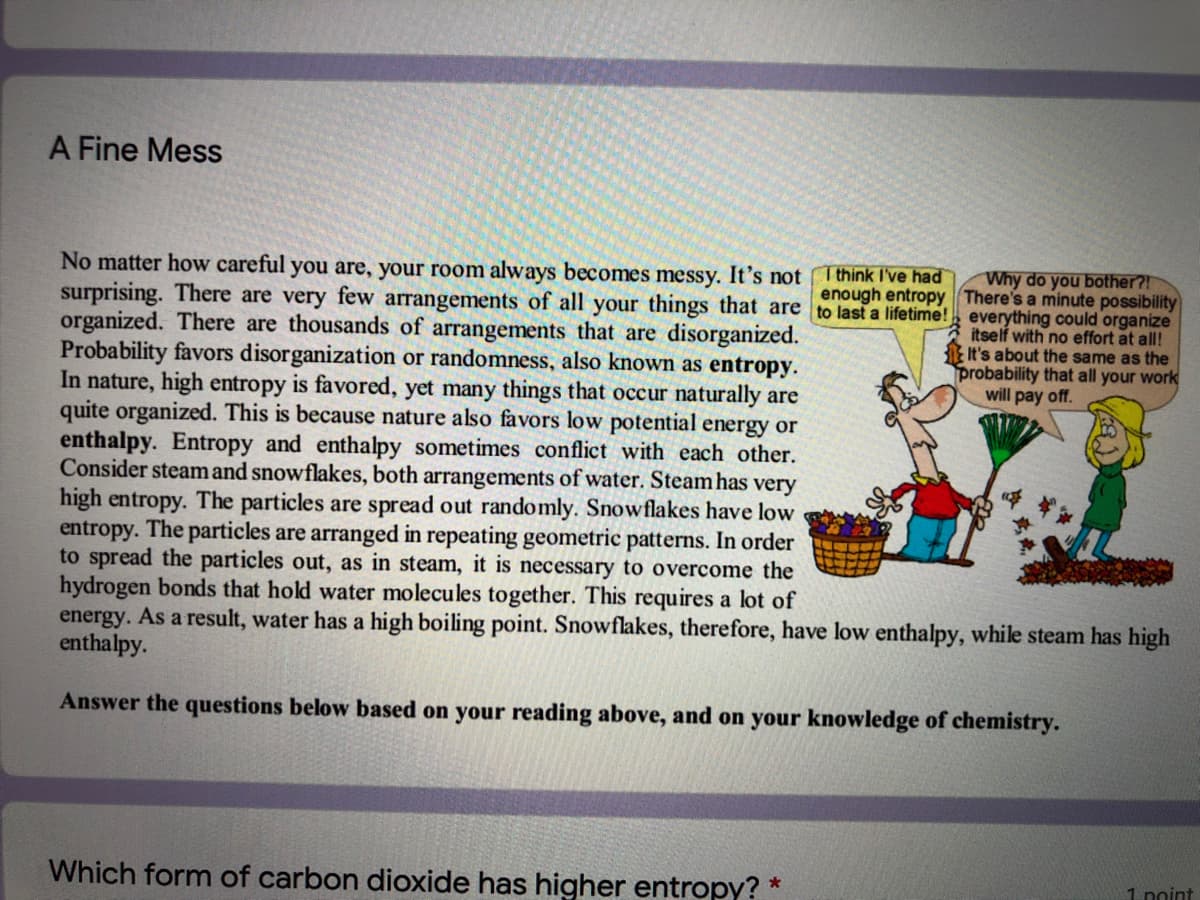Principles of Modern Chemistry
8th Edition
ISBN:9781305079113
Author:David W. Oxtoby, H. Pat Gillis, Laurie J. Butler
Publisher:David W. Oxtoby, H. Pat Gillis, Laurie J. Butler
Chapter13: Spontaneous Processes And Thermodynamic Equilibrium
Section: Chapter Questions
Problem 49AP
Related questions
Question
100%
The products have higher entropy than the reactants explain why
H2O (s) —> H2O (l)

Transcribed Image Text:A Fine Mess
Why do you bother?!
enough entropy There's a minute possibility
No matter how careful you are, your room always becomes messy. It's not I think I've had
surprising. There are very few arrangements of all your things that are to last a lifetime! everything could organize
organized. There are thousands of arrangements that are disorganized.
Probability favors disorganization or randomness, also known as entropy.
In nature, high entropy is favored, yet many things that occur naturally are
quite organized. This is because nature also favors low potential energy or
enthalpy. Entropy and enthalpy sometimes conflict with each other.
Consider steam and snowflakes, both arrangements of water. Steam has very
high entropy. The particles are spread out randomly. Snowflakes have low
entropy. The particles are arranged in repeating geometric patterns. In order
to spread the particles out, as in steam, it is necessary to overcome the
hydrogen bonds that hold water molecules together. This requires a lot of
energy. As a result, water has a high boiling point. Snowflakes, therefore, have low enthalpy, while steam has high
enthalpy.
itself with no effort at all!
It's about the same as the
probability that all your work
will pay off.
Answer the questions below based on your reading above, and on your knowledge of chemistry.
Which form of carbon dioxide has higher entropy? *
1 noint
Expert Solution
This question has been solved!
Explore an expertly crafted, step-by-step solution for a thorough understanding of key concepts.
This is a popular solution!
Trending now
This is a popular solution!
Step by step
Solved in 2 steps with 2 images

Knowledge Booster
Learn more about
Need a deep-dive on the concept behind this application? Look no further. Learn more about this topic, chemistry and related others by exploring similar questions and additional content below.Recommended textbooks for you

Principles of Modern Chemistry
Chemistry
ISBN:
9781305079113
Author:
David W. Oxtoby, H. Pat Gillis, Laurie J. Butler
Publisher:
Cengage Learning

Chemistry for Engineering Students
Chemistry
ISBN:
9781285199023
Author:
Lawrence S. Brown, Tom Holme
Publisher:
Cengage Learning

Chemistry for Engineering Students
Chemistry
ISBN:
9781337398909
Author:
Lawrence S. Brown, Tom Holme
Publisher:
Cengage Learning

Principles of Modern Chemistry
Chemistry
ISBN:
9781305079113
Author:
David W. Oxtoby, H. Pat Gillis, Laurie J. Butler
Publisher:
Cengage Learning

Chemistry for Engineering Students
Chemistry
ISBN:
9781285199023
Author:
Lawrence S. Brown, Tom Holme
Publisher:
Cengage Learning

Chemistry for Engineering Students
Chemistry
ISBN:
9781337398909
Author:
Lawrence S. Brown, Tom Holme
Publisher:
Cengage Learning

Chemistry: The Molecular Science
Chemistry
ISBN:
9781285199047
Author:
John W. Moore, Conrad L. Stanitski
Publisher:
Cengage Learning

Chemistry: Principles and Reactions
Chemistry
ISBN:
9781305079373
Author:
William L. Masterton, Cecile N. Hurley
Publisher:
Cengage Learning